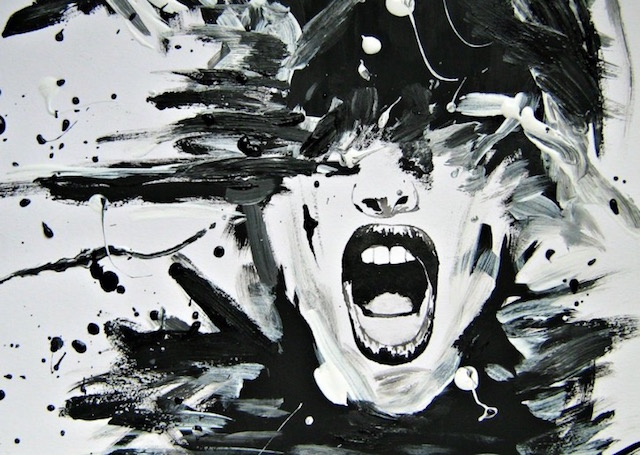When my time gets wasted, I get angry.
My whole body tenses up. My head gets hot and prickly. I literally feel the nerves tingling as the feeling races up and down my spine, spreading out to my extremities.
My palms start to sweat and I clench my fists.
I feel my breath growing more shallow as my chest constricts and my blood pressure rises.
I can feel my blood pressure rising, and it feels as though my blood is boiling. My next breath catches in my throat and it feels as though I might just suffocate.
The fight-or-flight response kicks in, and I want to just storm away. Or throw up.
In that moment, I feel as though I might just explode. It feels as if I will explode if I don’t do something.
It’s overpowering to the point I almost can’t deal with it. It used to feel as though I was a pressure cooker on the verge of blowing my top. When I was a kid, I felt my anger so intensely that it scared me. The word used to send a feeling of revulsion through me. The feeling of anger creeping up my spine, flushing my skin, tensing my muscles as my heart started to pound—I despised it. I denied it; I did anything to pretend I never felt anger.
It scared me. My emotions were so overpowering as a child, and I didn’t learn how to effectively release and work through them, so I just learned to shove them down and put a lid on them. I wouldn’t admit or acknowledge my emotions, which isn’t exactly a healthy way to live. In my house, we didn’t spend time talking about our emotions, nor was anyone teaching anyone else healthy ways to express and deal with them.
All I knew was that I didn’t want to be a rager or a yeller, so I stuffed it in deep out of fear.
But not anymore. Now I have learned that we can make friends with anger. We can embrace it with maitri, compassion, and humor. Like an errant, wayward child, I have learned to smile upon my anger when it comes up, and I breathe into it with mindfulness and compassion. I have truly come to believe that anger is our friend and an excellent tool for personal growth.
This doesn’t mean that it doesn’t still get the best of me some days. I sure do blow my top occasionally. The difference is that, for me, blowing my top is an improvement because I’m actually expressing the anger. And while it’s not my ideal behavior, it’s a lot better than the denial of anger dance that I used to undertake—a dance that almost killed me. So, today I choose to cut myself some slack and just go with it. I’m here to have a human experience, and what is a human experience but one of the physical realm? And there is certainly no more physical emotion than anger.
I have a long way to go, but today I’m okay with that. Each time I handle a challenge with the Zen grace of the Dalai Lama, I can celebrate. But you know what else? Each time I have an angry outburst that’s less Dalai Lama and more The Exorcist, I can celebrate those too! You know why? Because they’re human and I’m human, and the spiritual path is less about achieving the ideal than it is about the journey in all of its human messiness.
So what can anger teach us?
First off, anger can be a wonderful teacher when it comes to our boundaries and finding out what is important to us. For example, if I feel angry when someone says something untrue and negative about me, this allows me to see (if I am honest with myself) that my reputation is valuable to me. If someone threatens my family, I get angry. This shows me that their well-being is important to me. If we look carefully and honestly, we will see that we have no angry reaction to the things that don’t hold value in our lives.
Remember, underneath all the feelings are…more feelings. And anger is secondary. We feel anger to cover up feeling hurt or threatened. More often than not, if we are honest with ourselves, we find that someone hurt us and we felt angry. Or they posed some type of threat to our comfort, wants, or needs.
For example, if someone lied about me at work, I would be angry. Not simply because it’s messed up, but more so because a lie could make me look bad, which could then affect my standing at work, which is directly tied to my financial security. So the source of the anger then becomes the perceived threat to my financial security.
Some emotions are easier for us to feel and express than others. Think about the feelings that are more socially sanctioned, more comfortable—joy, love, happiness, and anything pleasant. The pain of grief, the ferocity of anger, the isolation of fear and the unremitting stress of frustration are difficult for everyone, especially when we try to bear them alone. That is why we need to deprogram our societal standards that tell us to hide our emotions. Stuffing our emotions, like anger, is unhealthy and causes much harm to us.
Emotions are not meant to stay stuck, they are meant to flow like energy. They are energy. The English word emotion is derived from the French word mouvoir. The French is based on the Latin word emovere, where e means “out” and movere means “move.” Not stay inside. But to move—out. So move that anger out! Let it go.
One of the best things we can do is question our anger. When we can pause and breathe into the anger before reacting, we learn a crucial lesson of self-restraint and discipline. In this moment, we gain some clarity where we can explore what is triggering us. When we undertake this exploration, digging deep into the dark emotions, we can learn the most about ourselves. This also creates space for deeper emotions to rise up, which results in great healing.
Miriam Greenspan puts it beautifully:
“The ‘dark emotions’ are inevitable. They are part of the universal human experience and are certainly worthy of our attention. They bring us important information about ourselves and the world and can be vehicles of profound transformation.”
So the next time you feel anger rising, welcome it. Sit with it. Be open to the lesson it holds for you and honor it.
Above all, breathe!
I’d love to hear about how you deal with anger in the comments below.
~
~
~
Author: Lindsay Carricarte
Image: DeviantArt
Editor: Travis May


 Share on bsky
Share on bsky





Read 0 comments and reply